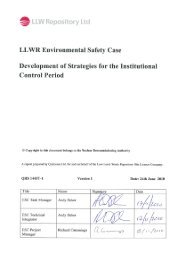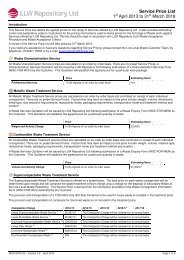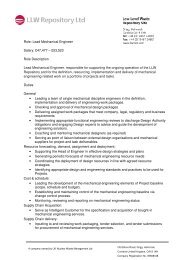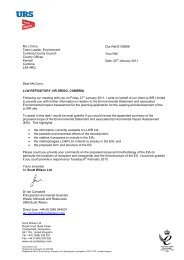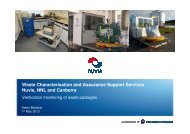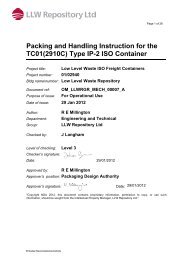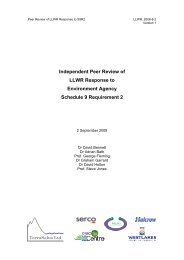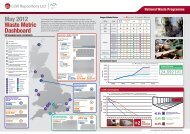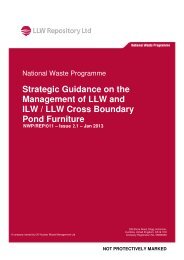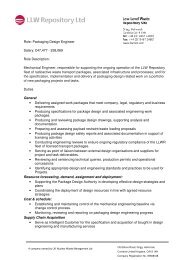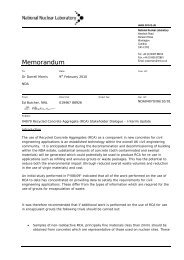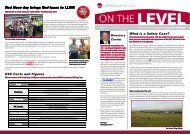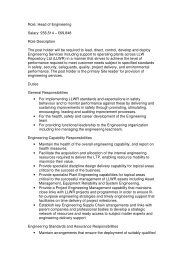Baldwin TD and Hicks TW, Assessment Calculations for Human ...
Baldwin TD and Hicks TW, Assessment Calculations for Human ...
Baldwin TD and Hicks TW, Assessment Calculations for Human ...
You also want an ePaper? Increase the reach of your titles
YUMPU automatically turns print PDFs into web optimized ePapers that Google loves.
0977-6Version 16 Results<strong>Calculations</strong> have been undertaken to evaluate potential doses from inadvertenthuman intrusion into the additional vaults <strong>for</strong> each of the two inventory casesdiscussed in Section 5.1. The starting point <strong>for</strong> evaluating the impacts of intrusion isthe time of withdrawal of regulatory control from the site, which is assumed to beabout 100 years after all engineering <strong>and</strong> decommissioning of active systems iscomplete <strong>and</strong> the site has been closed. For the Reference Disposal Area considered inthe previous report this led to an assumption of the end of the period of management<strong>and</strong> regulatory control at 2180. Assuming it takes 3 years to complete cappingfollowing completion of disposals to Vault 20 in the Extended Disposal Area, the siteclosure date <strong>for</strong> inventory cases A <strong>and</strong> B will be 2130, indicating an end toinstitutional control at 2230. Thus, doses from the geotechnical investigation events(B1), construction <strong>and</strong> occupancy events (B3) <strong>and</strong> smallholder event (B7) <strong>for</strong> theExtended Disposal Area have been evaluated from 2230.The earliest erosion contact of the site is assumed to be 300 years after present (AP),which is considered unlikely but credible. The latest time at which the site will becontacted by erosion, which includes the possibility that some measures are taken toinstall <strong>and</strong> maintain coastal defences <strong>for</strong> a period, is about 3,000 years AP. It isexpected that the site will be completely destroyed <strong>and</strong> dispersed by coastal erosionby about 5,000 years AP. Thus, the intrusion events are considered from the year2230 to the year 7000.The hazard presented by the disposal system in the longer term has also beenconsidered assuming that the facility is not eroded. Such calculations are importantbecause the inventory of some radionuclides will increase in the long term, notably226 Ra <strong>and</strong> its daughters growing in from 234 U via long-lived 230 Th. The longest time<strong>for</strong> which it is considered credible to continue calculations <strong>for</strong> the occupancy <strong>and</strong>smallholder events B3 <strong>and</strong> B7 is 10,000 years AP (i.e. until the year 12,000). Thestate of the disposal system cannot be predicted with any confidence on such longtimescales. There<strong>for</strong>e, the characteristics of the system, such as cap <strong>and</strong> profilethickness, are assumed to be the same as at closure. Note that the human intrusionassessment ignores any leaching of radionuclides in infiltrating water <strong>and</strong> subsequentmigration away from the site, which is very cautious on such long timescales.The following subsections present results <strong>for</strong> each intrusion event <strong>for</strong> inventory casesA <strong>and</strong> B. Results <strong>for</strong> all the intrusion events have been produced using Version 1.2 ofthe GoldSim EDA human intrusion model. The code runs are numbered 1.2.0 (CaseA) <strong>and</strong> 1.2.1 (Case B).Dose calculations are shown in terms of results at different GoldSim model grid cells,which map to trenches <strong>and</strong> vaults as indicated in Figure 3.2 <strong>and</strong> summarised in Figure6.1. The model grid was developed <strong>for</strong> the Reference Disposal Area human intrusionassessment calculations (columns 1 to 9) <strong>and</strong> has been used <strong>for</strong> the Extended DisposalArea (columns 10 <strong>and</strong> 11) to ensure consistency between the assessments.Galson Sciences Ltd 20 21 March 2011



